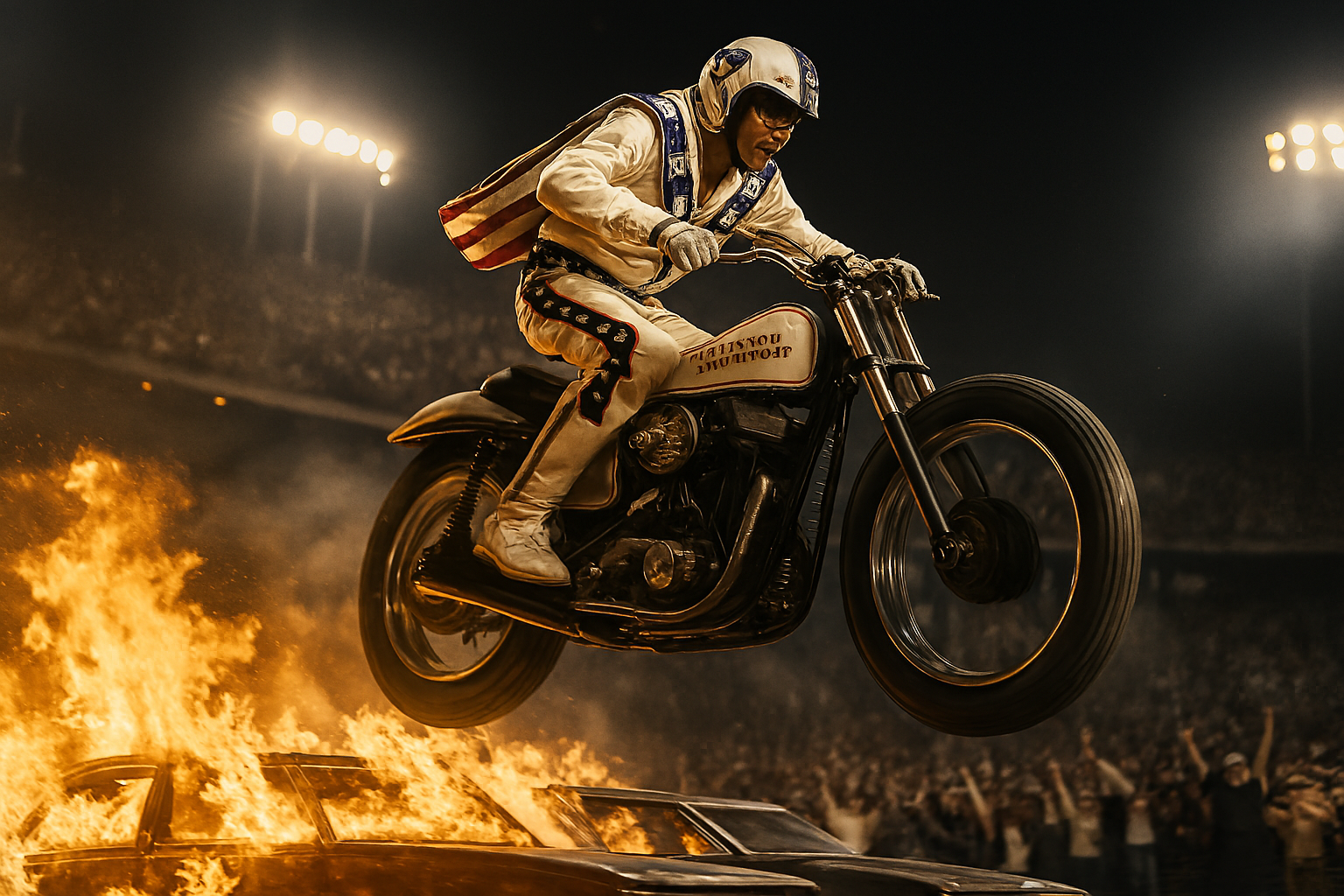Evel Knievel—the name itself is a defiant snarl, synonymous with shattered bones and the audacious, televised pursuit of the impossible.1 Born Robert Craig Knievel Jr. in Butte, Montana, he transformed from a rebellious youth into the world’s most famous stunt performer, defining an entire generation’s understanding of risk, spectacle, and American bravado.2 Dressed in his iconic star-spangled leather jumpsuits, Knievel did not just jump objects; he challenged fate, performing more than 75 ramp-to-ramp motorcycle stunts and achieving a cultural ubiquity that few athletes or entertainers could ever rival.3
The Birth of an Icon and the Showman’s Blueprint
Knievel’s early life was marked by an intense need for adrenaline, leading him through odd jobs—including a stint in the copper mines where he was fired for crashing an earth mover while attempting a wheelie—and involvement in semi-pro hockey, rodeo, and ski jumping.4 His career as a motorcycle daredevil began in the mid-1960s, initially as a way to promote a motorcycle dealership he co-owned.5
His first major stunt, in 1965, set the template for his career: a spectacular, high-stakes jump over rattlesnakes and a caged cougar.6 Although he landed short and sprained his ankle, the drama of the near-fatal crash thrilled the crowd and garnered immense publicity. Recognizing the power of the spectacle, particularly failure, Knievel began to refine his persona and his business model.
He changed his name to the memorable “Evel Knievel” (allegedly to soften the implication of “Evil Knievel”) and developed an unparalleled flair for showmanship.7 Before each stunt, he would deliver motivational, anti-drug speeches, creating a public image of a flawed but morally upstanding hero.8 He meticulously managed the pre-event hype, often using his near-crashes to build anticipation for the next, even more dangerous, attempt.
The Jumps That Defined a Decade 💥
Knievel’s career was a series of escalating challenges, often televised on ABC’s Wide World of Sports, which transformed him into a global phenomenon:9
- The Caesars Palace Fountain Jump (1967): This stunt in Las Vegas vaulted him to international fame.10 Attempting to clear 11$141$ feet over the casino’s fountains on a Triumph Bonneville, Knievel successfully cleared the water but crashed spectacularly on the landing ramp.12 The wreck left him in a 29-day coma with a fractured skull, crushed pelvis, and multiple broken bones. The brutal, slow-motion footage of the crash became one of the most famous clips in television history.
- The Los Angeles Coliseum Car Jump (1973):13 Demonstrating his recovery and relentless spirit, Knievel successfully jumped over 50 stacked cars at the LA Coliseum, a massive feat that set a world record for the most vehicles jumped.14
- The Wembley Stadium Bus Jump (1975): In front of 15$90,000$ live spectators in London, Knievel attempted to clear 16$13$ buses on his Harley-Davidson XR-750—a heavier, less suitable motorcycle for jumping, often used due to an endorsement deal.17 He made the distance but crashed again on the landing, fracturing his back. In a legendary display of bravado, he addressed the crowd, apologized for failing the landing, and dramatically walked away, announcing his retirement (briefly).
- The Kings Island Bus Jump (1975):18 Later that same year, Knievel successfully jumped 14 Greyhound buses at Kings Island, Ohio, his longest successful jump at over 19$130$ feet.20
The Audacity of the Snake River Canyon 🚀
In his quest for the ultimate spectacle, Knievel set his sights on the most formidable natural obstacle: the Grand Canyon.21 When the U.S. government denied him permission to jump federal land, he turned his focus to the Snake River Canyon in Twin Falls, Idaho.22
This was not to be a motorcycle jump. To clear the quarter-mile-wide, 23$500$-foot-deep gorge, Knievel required a bespoke vehicle: the Skycycle X-2.24 This was essentially a steam-powered rocket—a custom-built, futuristic-looking contraption designed by former U.S. Navy engineer Robert Truax.
The jump on September 8, 1974, was a massive pay-per-view television event.25 Knievel, wearing a pressurized suit, climbed into the Skycycle’s cockpit. Upon launch, however, the main parachute malfunctioned and deployed prematurely, likely due to an aerodynamic design flaw in the chute retention cover.26 The massive drag slowed the rocket’s ascent and momentum, causing it to drift back toward the canyon floor, landing just short of the river and bouncing onto the canyon wall. Incredibly, Knievel survived with only a broken nose and minor scrapes, a miraculous escape that became as famous as his successful jumps.
The Unbreakable Legacy of Broken Bones 🤕
During his career, Evel Knievel claimed to have broken a staggering 433 bones—earning him a place in the Guinness World Records as the survivor of the most bones broken in a lifetime.27 Beyond the sheer physical cost, his legacy is profound:
- Cultural Icon: Knievel transcended sports, becoming a cultural icon of the 1970s.28 His image was everywhere, from best-selling Ideal Stunt Cycle action figures to pinball machines and movies, making him a commercial powerhouse and a hero to millions of children.29
- The Father of Extreme Sports: Knievel’s blend of outrageous stunts, television spectacle, and personal risk paved the way for modern extreme sports and the X Games.30 He transformed the daredevil act into a legitimate, marketable entertainment phenomenon.
- Inspiring the Impossible: His philosophy was simple: “You only live once, so let’s get on with it.” He taught a generation that it was okay to fail dramatically, so long as you had the courage to try something truly impossible.
Evel Knievel was an American myth wrapped in red, white, and blue leather, a man who, despite every spectacular crash and severe injury, always got up to face the next challenge.31 His death in 2007, from lung disease, closed the book on the life of the “Last Gladiator,” but his rebellious spirit continues to inspire all who dare to fly.32
